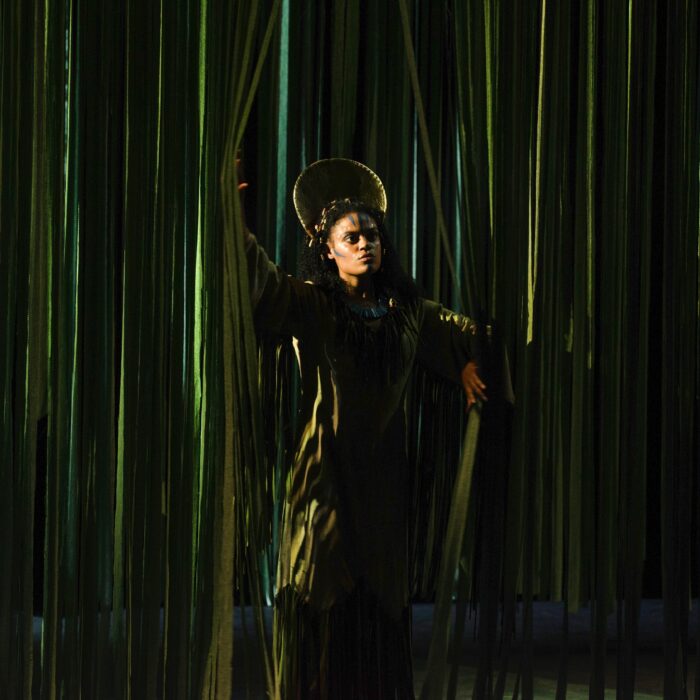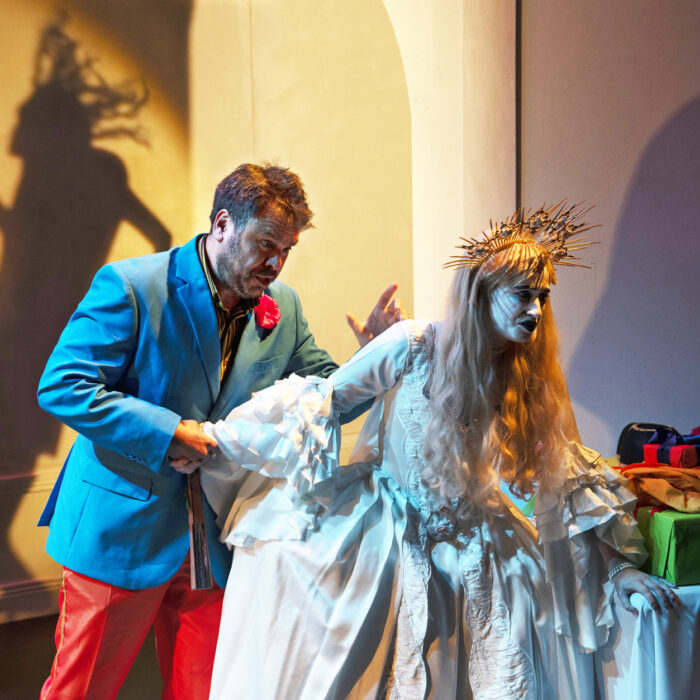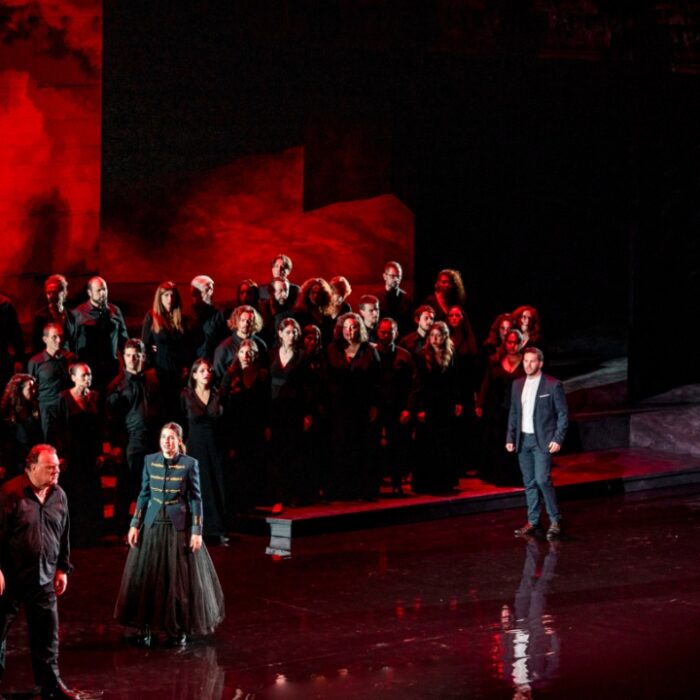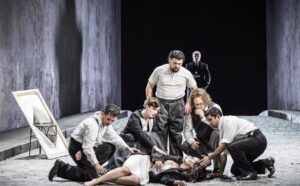
Glyndebourne Festival Opera 2025 Review: La Bohème
By Mike Hardy(Photo: Marc Brenner)
Considered one of the most beloved and frequently performed operas in the world, “La Bohème” is the perfect blend of exquisite music, timeless tales, and romantic themes, an ideal first opera for any budding enthusiast.
Its incarnations have included a rock musical, placing the opera in space, in a hospital, as well as a setting based in 1930’s Nazi Germany among others.
Floris Visser’s production sees our Bohemians living and existing, (ostensibly at least), on the streets. Inspired by the photographs of Hungarian-French photographer, Brassaï, and his famous portraits of Paris in the 1920s; set designer Dieuweke van Reij settles on the one, single set. A cobbled, catacomb-like underpass, heavy with smog and foreboding in equal measure, serving as the working areas for Rodolfo the poet and Marcello the artist in the first and final acts, Café Momus in the second act, by virtue of the employment of the stacked tables and chairs that remain throughout to the side of the set, and the salacious streets and taverns of Barrière d’Enfer in the third.
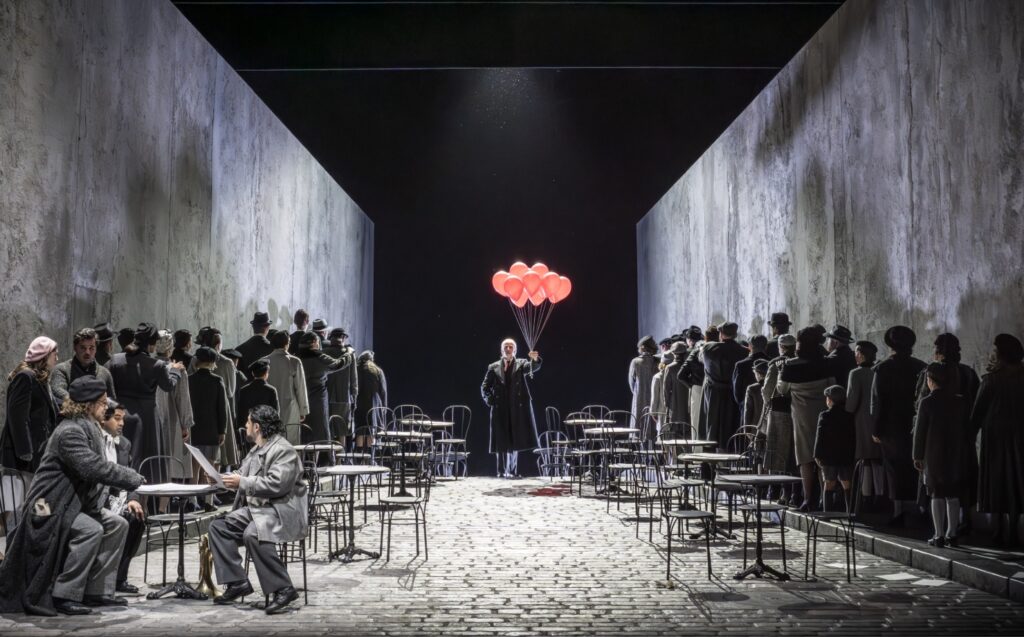
(Photo: Marc Brenner)
It almost works, but it requires one to consider both the allegorical and the metaphorical to keep up. One presumes the dark, cobbled street to represent the travails of life, with the hope of a better existence at the end of it, where the street dips into darkness and the unknown, where prostitutes lean against the walls. Other than the few splashes of deliberate color to highlight key junctures, the set remains monochrome throughout.
Of course, this austere, avant-garde approach isn’t unique to this opera. Jonathan Miller’s 2009 production was also set in 1930’s Paris and was also influenced by the photographic work of Brassaï, among others. Visser’s effort is all the more darker, alas; unquestionably film noire, and credit must be afforded to lighting director Alex Brok whose sterling efforts prove essential in enhancing the tale, not least in the third act where doors on either side of the set are employed to alternately bathe the scene in warm light to emulate the glow of the tavern, and harsh, white, intrusive lights from the other, facilitating the use of clever and compelling shadow-work.
Jon Morrell’s costumes are stylish and effective, but seem more 1950’s than 1930’s, not that any accurate time frame is of consequence.
Stellar Cast
The most significant inclusion in this production, however, first performed in 2022, is hinted at in the cast list detailed in the program: Christopher Lemmings plays the part of both Parpignol, the toy seller, and…death!
Without this notification, I consider it quite possible that some of the audience would be both perplexed and more than a little perturbed by the tall, disconcerting Lemmings, who accompanies seamstress and love interest Mimì from her first appearance and remains with her at every turn. Resembling a lead from a ‘Hammer House of Horror’ movie, he moves with chilling effect throughout, his foreboding demeanour made all the more impactful in the second act where he portrays Parpignol, replete with vivid red, helium-filled ballons which he hands out to the gathered children, before retaining one for himself, acting as a beacon in the dull, colourless, crowded scene.
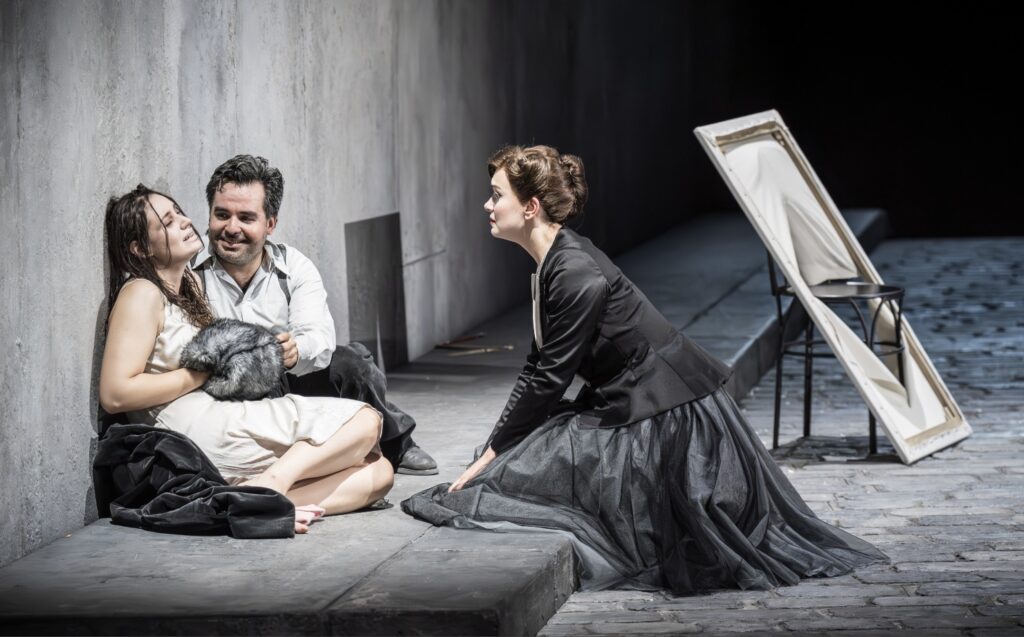
(Photo: Marc Brenner)
Mimì is portrayed here by Romanian soprano, Aida Pascu. Recent recipient of the Young Artist of the Year 2024 of the International Classical Music Awards (ICMA), on this performance I should say the award was well deserved. She sings with evocative sweetness and is a fine actress, to boot. Her upper register isn’t yet fully developed, her top notes lacking some depth, but her final acts with Rodolfo are exquisite, where her voice adopts a beautifully rich, mezzo quality in the lower registers.
South America has produced some wonderful tenors over the years, and at first sound, Colombian Andrés Agudelo makes great strides in joining them. He has a bright, clear, burnished tenor that resonates well. He was almost totally without any legato throughout the evening. He was frequently prone to blooming well and then fading in the same line, and at times, was clearly caught short for air. This required him to take breaths at incongruous moments, and in the passage, towards the end of the keynote aria, ‘Che gelida manina,’ he began the line ‘La speranza!’ noticeably late, well after the accompanying orchestral bars, in order to have any kind of sustain on the C. In his duet with Marcello in the final act, his ‘O Mimì, tu più non torni’ required several breaths to complete his opening passages, which only served to highlight Marcello’s passages in response, spun on the one breath. That’s not to detract from the beauty of his voice which is most apparent, but merely an observation of what I believe to be a technical shortcoming, at least on this occasion.
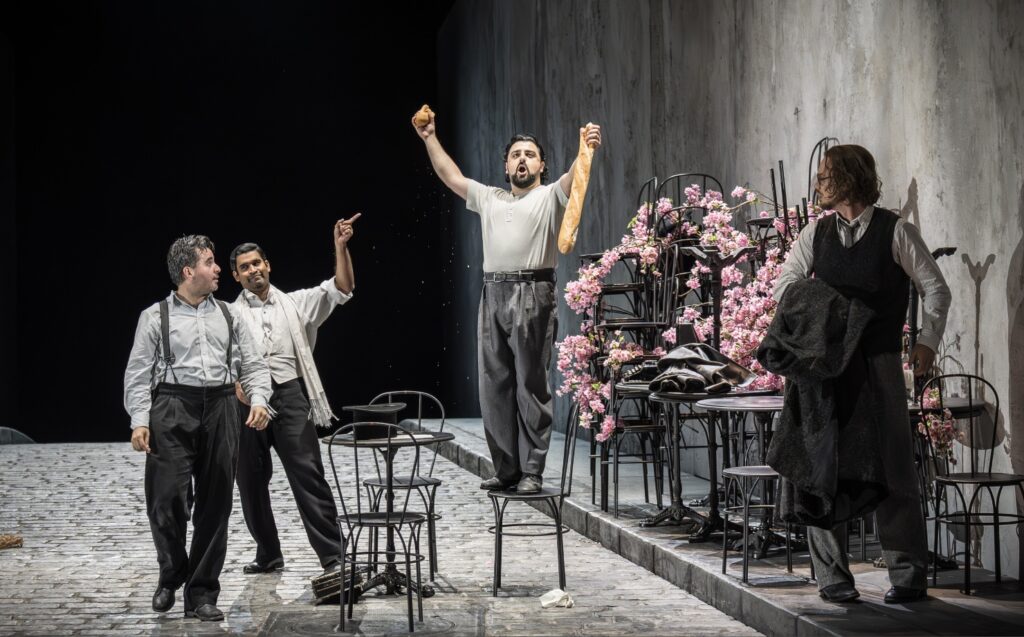
(Photo: Marc Brenner)
By contrast, Aksel Daveyan as Marcello was a real powerhouse. Stentorian and rich, his shenanigans with Musetta in the second act were a joy and his collaboration with Mimì in the third act was evocative. His aforementioned duet, ‘O Mimì, tu più non torni,’ was masterful and heartfelt and, for me, he was the best voice of the evening.
That’s also not to detract from remaining Bohemians; Darwin Prakash as Schaunard was most animated, delivering an engaging ‘Or vi dirò: quest’oro’ in a splendidly rich and warm baritone. He positively lit up the stage with his antics throughout and has great charisma.
Markus Suihkonen, a young Finnish bass, completes the quartet with his interpretation of Colline, the philosopher. Treacle dark with a fine, sonorous tone. His ‘Or vi dirò: quest’oro‘ was as accomplished as any I have heard and almost sacrilegiously received no applause from the audience.
Camilla Harris delivered a remarkably mature Musetta for a soprano so young; confident, feisty and convincingly spirited. Her ‘Quando m’en vo’ was wonderfully coquettish, whilst her lines in the final act were delivered with suitable solemnity. She has a beautifully nuanced soprano voice, and I would love to hear her when she has further enriched her palette with more colours.
Special mention goes to Darren Jeffery in the duel roles of Benoit and Alcindoro. Far removed from the normal, dithering buffoon that this role usually demands, his landlord here was a pretty brutish, almost menacing inebriate. Cavernous in voice, his stature and performance here lent a welcome malevolence to the role.
Musical Highlights
Conductor Adam Hickox guided the Glyndebourne Sinfonia along masterfully, paying scrupulous attention to the stage as well as to his orchestra, who produced a beautiful rendition of Puccini’s score.
The Glyndebourne Chorus and Youth Opera created a splendid visual and auditory spectacle in the second act, and as usual, were in sterling voice.
Overall, and without wishing to introduce any spoiler alerts, I have to conclude that this production left me with hugely mixed reservations. Its predominant feature, here, the DEATH character, is both its strength and, for me at least, its weakness. Weak, because his omnipresence impacted the emotional structure of the relationship between Rodolfo and Mimì at virtually every turn. His continued presence throughout their courtship significantly detracted from the romanticism that is a pivotal axiom in “La Boheme,” and at times his brooding presence almost usurped that of the main characters. Yes, Mimì is going to die and that is one of the chief narratives in the whole opera. Virtually NO-ONE attending the opera house would be ignorant of that fact. But the perpetual accompaniment of her by his foreboding figure did little in the way of enhancing or reinforcing that fact. It would have been far more potent had his presence been minimal, appearing at innocuous or as unexpected brief instances.
That said, its strength lies in Death’s presence, in the final moments of the opera, which were made all the more profound and tear-jerking by his interactions with Mimì as he slowly makes his approach to her, marking, or perhaps even instigating her passing, by dropping his head to one side, coinciding with her dropping hers, before she rises, in spirit form, and walks slowly with him to the inky blackness of the street backdrop and into oblivion.
As a piece of dramatic and emotive theatre, it was absolutely masterful. As the principal hook for a “La Boheme,” I remain unconvinced.
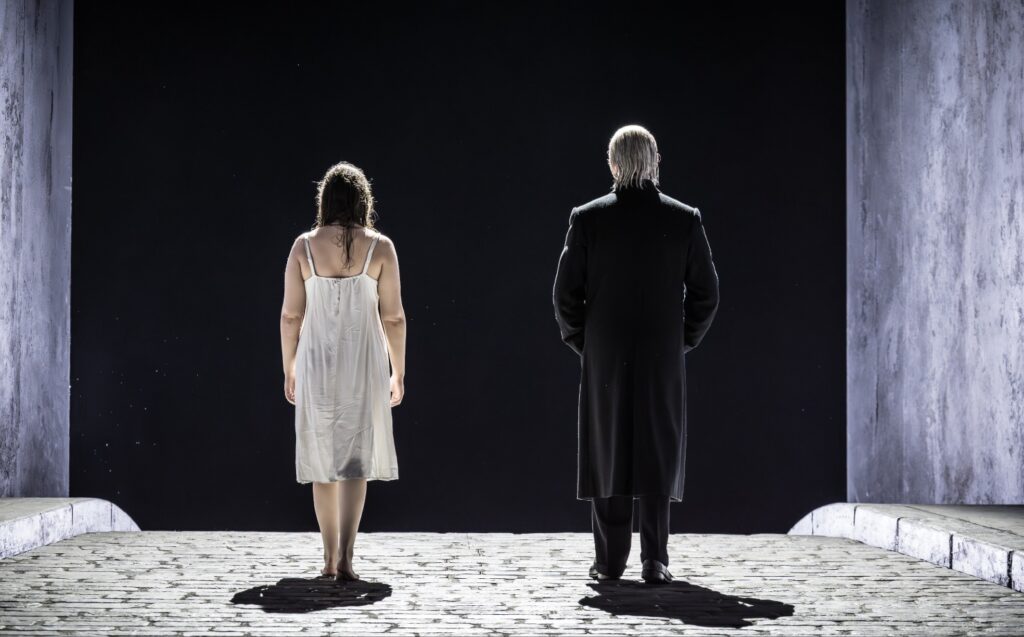
(Photo: Marc Brenner)

